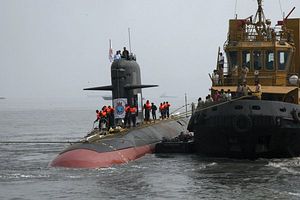French shipbuilder Direction des Constructions Navales Services (DCNS) suffered a massive leak of documents detailing the top-secret combat capabilities of the Indian Navy’s Scorpene-class (Kalvari-class) diesel-electric attack submarine, which DCNS has been building with the support of India’s state-run Mazgaon Docks Limited (MDL) in Mumbai for the past decade, according to an Australian newspaper report.
The documents were written by DCNS in 2011 for India and purportedly leaked by a former French Navy officer who was at that time a DCNS subcontractor. “The data is then believed to have been taken to a company in Southeast Asia, possibly to assist in a commercial venture for a regional navy,” The Australian reports. “It was subsequently passed by a third party to a second company in the region before being sent on a data disk by regular mail to a company in Australia. It is unclear how widely the data has been shared in Asia or whether it has been obtained by foreign intelligence agencies.”
The 22,400 pages leak includes highly classified documents marked “Restricted Scorpene India” outlining the Scorpene-class sub’s diving depths, range, and endurance, magnetic, electromagnetic and infrared data, and details of the submarine’s combat system, including the torpedo launch system.
DCNS, under a $4.16 billion contract (known as Project 75-I) awarded in 2005, is assembling six Scorpene-class (Kalvari-class) diesel electric submarines for the India Navy in Mumbai. The deal involved extensive technology transfer agreements and 30 percent of the submarine, including the sub’s pressure hull, is made in India. After a four-year delay, the first Kalvari-class boat is expected to be inducted in September 2016.
“The data seen by The Australian includes 4,457 pages on the submarine’s underwater sensors, 4,209 pages on its above-water sensors, 4,301 pages on its combat management system, 493 pages on its torpedo launch system and specifications, 6,841 pages on the sub’s communications system and 2,138 on its navigation systems,” the report reads.
According to The Australian, the leaked documents reveal:
- “The stealth capabilities of the six new Indian Scorpene submarines
- The frequencies at which the subs gather intelligence
- The levels of noise the subs make at various speeds
- Diving depths, range, and endurance
- Magnetic, electromagnetic and infra-red data
- Specifications of the submarine’s torpedo launch system and the combat system
- Speed and conditions needed for using the periscope
- Propeller’s noise specifications
- Radiated noise levels when the submarine surfaces”
DCNS has issued a statement pledging to investigate the leak with the support of French authorities. “DCNS has been made aware of articles published in the Australian press related to the leakage of sensitive data about (the) Indian Scorpene,” the company said in a statement reported by Defense News. “This serious matter is [being] thoroughly investigated by the French national authorities for defense security… This investigation will determine the exact nature of the leaked documents, the potential damages to DCNS customers as well as the responsibilities for this leakage.”
The leak could affect a separate DCNS deal with Australia over the construction of 12 Shortfin Barracuda Block 1A subs, a diesel-electric derivative of DCNS’ Barracuda-class nuclear attack submarine, for the Royal Australian Navy (RAN) under the RAN’s so-called SEA 1000 Future Submarine Program.
































